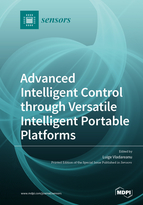Advanced Intelligent Control through Versatile Intelligent Portable Platforms
A special issue of Sensors (ISSN 1424-8220). This special issue belongs to the section "Intelligent Sensors".
Deadline for manuscript submissions: closed (31 March 2020) | Viewed by 87924
Special Issue Editor
Interests: robot control; intelligent control; artificial intelligence; intelligent agents; intelligent sensor systems; advanced intelligent control methods and techniques; intelligent decision support systems; versatile intelligent portable platforms; human–robot (H2R) interaction systems; machine-to-machine (M2M) interfaces; prediction; machine learning; IoT technologies; cyberphysical systems; IT Industry 4.0 concept; industrial systems in the digital age; intelligent sensors applied to rescue robots; firefighting robots; rehabilitation robots; robot-assisted surgery; domestic robots
Special Issues, Collections and Topics in MDPI journals
Special Issue Information
Dear Colleagues,
Advanced intelligent control is a rapidly developing, complex, challenging field with great practical importance and potential. It is an inter-disciplinary field, which combines and extends theories and methods from control theory, computer science, and operations research areas with the aim of developing controllers that are highly adaptable to significant unanticipated changes.
Intelligent control imitates human intelligence for learning, decision-making, and problem solving. These human characteristics encompass experience, learning, adapting, and changing methods of approach to solve problems. Intelligent control techniques allow the development of an environment to recreate the advantages of natural intelligence with artificial intelligence.
Advances in sensors, actuators, computation technology, and communication networks provide the necessary tools for the implementation of intelligent control hardware. Practical applications using intelligent sensors for this control method have emerged from artificial intelligence and computer-controlled systems as an interdisciplinary field. These are aimed at a variety of relevant scientific research fields involving machine learning, including deep learning, bio-inspired algorithms, petri nets, recurrent neural networks, neuro-fuzzy control, Bayesian control, genetic control, and intelligent agents (cognitive/conscious control) as well as extensions to traditional techniques such as neutrosophic logic, extenics control, and artificial intelligence in general.
This Special Issue aims to present and communicate new trends in the design, control, and applications of real-time intelligent sensor system control using advanced intelligent control methods and techniques. Thus, we welcome the submission of original research papers and review articles that report recent advancements in intelligent control using intelligent sensors. In particular, we encourage submissions related to the use of innovative multi-sensor fusion techniques integrated through Versatile Intelligent Portable (VIP) Platforms that combine computer vision, virtual and augmented reality (VR&AR), intelligent communication (e.g., remote control), adaptive sensor networks, and intelligent decision support systems (IDSS, e.g., remote sensing) and their integration with DSS, such as GA-based DSS, fuzzy sets DSS, rough sets-based DSS, intelligent agent-assisted DSS, process mining integration to decision support, adaptive DSS; computer vision based DSS, sensory and robotic DSS, human–robot (H2R) interaction systems, and machine-to-machine (M2M) interfaces.
We also invite authors to submit articles related to the utilization of new technologies with advanced intelligent control through Versatile Intelligent Portable Platforms, such as enhanced IoT technologies and applications in the 5G densification era, bio-inspired techniques for future manufacturing enterprise control, a cyber-physical systems approach to cognitive enterprise, development of the IT Industry 4.0 concept , industrial systems in the digital age, cloud computing, robotics and automation with applications such as human aid mechatronics, movement in unstructured and uneven environments for military applications, rescue robots, firefighting robots, rehabilitation robots, robot-assisted surgery, and domestic robots.
Prof. Dr. Luige Vladareanu
Guest Editor
Manuscript Submission Information
Manuscripts should be submitted online at www.mdpi.com by registering and logging in to this website. Once you are registered, click here to go to the submission form. Manuscripts can be submitted until the deadline. All submissions that pass pre-check are peer-reviewed. Accepted papers will be published continuously in the journal (as soon as accepted) and will be listed together on the special issue website. Research articles, review articles as well as short communications are invited. For planned papers, a title and short abstract (about 100 words) can be sent to the Editorial Office for announcement on this website.
Submitted manuscripts should not have been published previously, nor be under consideration for publication elsewhere (except conference proceedings papers). All manuscripts are thoroughly refereed through a single-blind peer-review process. A guide for authors and other relevant information for submission of manuscripts is available on the Instructions for Authors page. Sensors is an international peer-reviewed open access semimonthly journal published by MDPI.
Please visit the Instructions for Authors page before submitting a manuscript. The Article Processing Charge (APC) for publication in this open access journal is 2600 CHF (Swiss Francs). Submitted papers should be well formatted and use good English. Authors may use MDPI's English editing service prior to publication or during author revisions.
Keywords
- intelligent control
- robot control
- intelligent sensor systems
- intelligent decision support systems
- Versatile Intelligent Portable Platforms
- new technologies
- adaptive sensor networks
- virtual and augmented reality
- intelligent remote control and communication







